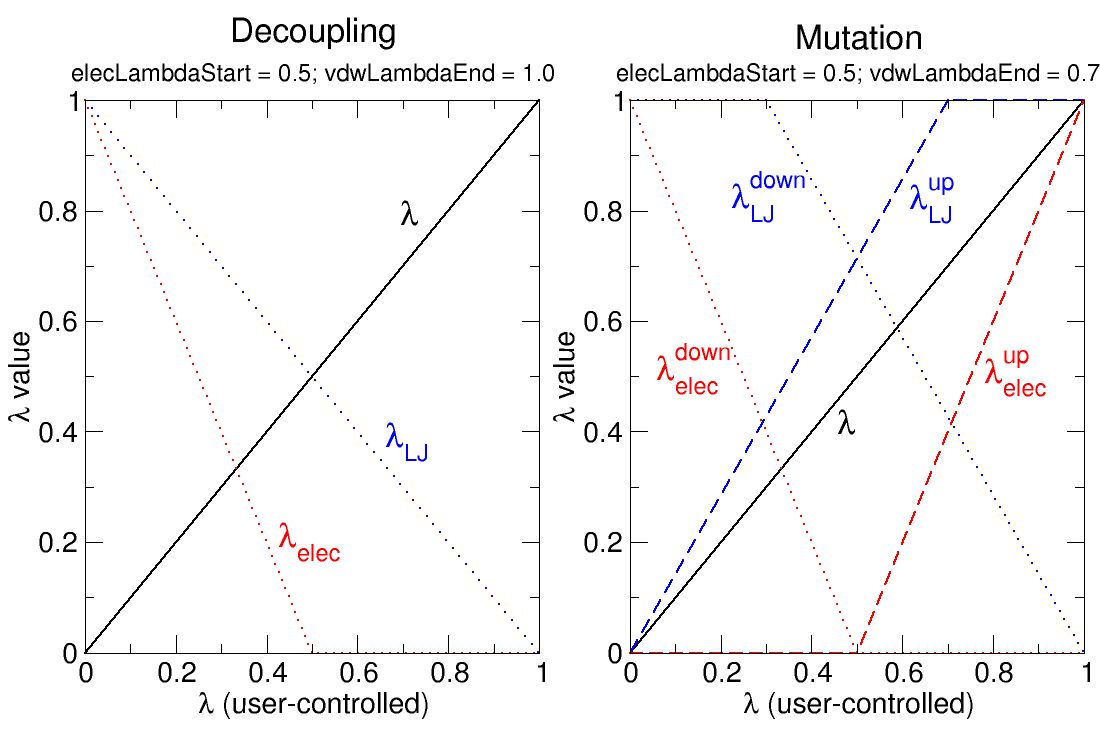The procedures implemented in NAMD are particularly
adapted for performing free
energy calculations that split the ![]() reaction path into a number of non-physical,
intermediate states, or ``windows''. Separate simulations
can be started for each window.
Alternatively, the TCL scripting ability of
NAMD can be employed advantageously
to perform the complete simulation in a single run.
An example, making use of such a script, is supplied at the end
of this section.
reaction path into a number of non-physical,
intermediate states, or ``windows''. Separate simulations
can be started for each window.
Alternatively, the TCL scripting ability of
NAMD can be employed advantageously
to perform the complete simulation in a single run.
An example, making use of such a script, is supplied at the end
of this section.
The following keywords can be used to run alchemical free energy calculations, whether FEP or TI.
In the current implementation, the electrostatic interactions of an exnihilated, or appearing, particle are linearly coupled to the simulation over the ![]() value range of alchElecLambdaStart - 1.0. At
value range of alchElecLambdaStart - 1.0. At ![]() values less than or equal to the user-defined value of alchElecLambdaStart, electrostatic interactions of the exnihilated particle are fully decoupled from the simulation. Coupling of electrostatic interactions then increases linearly for increasing values of
values less than or equal to the user-defined value of alchElecLambdaStart, electrostatic interactions of the exnihilated particle are fully decoupled from the simulation. Coupling of electrostatic interactions then increases linearly for increasing values of ![]() until
until ![]() =1.0, at which point electrostatic interactions of the exnihilated particle are fully coupled to the simulation.
=1.0, at which point electrostatic interactions of the exnihilated particle are fully coupled to the simulation.
For annihilated, or vanishing, particles the electrostatic interactions are linearly decoupled from the simulation over the ![]() value range of 0 - (1.0 - alchElecLambdaStart). At
value range of 0 - (1.0 - alchElecLambdaStart). At ![]() =0 electrostatic interactions are fully coupled to the simulation, and then linearly decreased with increasing
=0 electrostatic interactions are fully coupled to the simulation, and then linearly decreased with increasing ![]() such that at
such that at ![]() values greater than or equal to (1.0 - alchElecLambdaStart) electrostatic interactions are completely decoupled from the simulation. Two examples, shown in Figure 9, describe the relationship between the user-defined value of
values greater than or equal to (1.0 - alchElecLambdaStart) electrostatic interactions are completely decoupled from the simulation. Two examples, shown in Figure 9, describe the relationship between the user-defined value of ![]() and the coupling of electrostatic or vdW interactions to the simulation.
and the coupling of electrostatic or vdW interactions to the simulation.
 |
For an exnihilated particle, vdW interactions are fully decoupled at ![]() =0. The coupling of vdW interactions to the simulation is then increased with increasing values of
=0. The coupling of vdW interactions to the simulation is then increased with increasing values of ![]() such that at values of
such that at values of ![]() greater than or equal to alchVdwLambdaEnd the vdW interactions of the exnihilated particle are fully coupled to the simulation.
greater than or equal to alchVdwLambdaEnd the vdW interactions of the exnihilated particle are fully coupled to the simulation.
For an annihilated particle, vdW interactions are completely coupled to the simulation for ![]() values between 0 and (1 - alchVdwLambdaEnd). Then, vdW interactions of the annihilated particle are linearly decoupled over the range of
values between 0 and (1 - alchVdwLambdaEnd). Then, vdW interactions of the annihilated particle are linearly decoupled over the range of ![]() values between (1 - alchVdwLambdaEnd) and 1.0. VdW interactions are only fully decoupled when
values between (1 - alchVdwLambdaEnd) and 1.0. VdW interactions are only fully decoupled when ![]() reaches 1.0.
reaches 1.0.